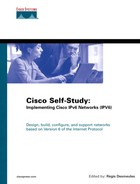Network Address Translation
Since 1992, CIDR has not been the only mechanism directly involved in slowing down the IPv4 address shortage. Over the years, the NAT mechanism (defined in RFC 1631), seen as a short-term solution, played a key role by allowing organizations to use few Internet globally unique unicast IP addresses for their large networks. NAT typically translates packets from a network, which uses globally unique unicast IP addresses or a private address space as defined by RFC 1918, to the Internet.
NOTE
IANA has reserved three blocks of IP addresses for private addressing. Address spaces 10.0.0.0/8, 172.16.0.0/12, and 192.168.0.0/16 are used for address translation with the Internet.
Figure 1-4 shows networks using private addressing. 10.0.0.0/8 and 192.168.0.0/16 are connected to the Internet through the same ISP using NAT. Because private addresses are not routed across the Internet, nodes on these private networks cannot be reached from the Internet.
Figure 1-4. Networks Connected to the Internet Using NAT with Private Addressing

Since 1990, the combination of CIDR, NAT, and private addressing has provided benefits to the Internet by slowing the depletion of IPv4 addresses.
Moreover, one of the arguments against deploying IPv6 is the use of NAT. This is seen by some as the permanent solution to the shortage of IPv4 address space. However, using NAT has many implications; these were taken into consideration during the engineering of IPv6. Some of these limitations are documented in RFC 2775 and RFC 2993:
NAT breaks IP's end-to-end model— IP was originally designed so that only endpoints (hosts and servers) have to handle the connection. The network itself, the underlying layers, and NAT do not have to handle connections.
The need to keep the state of connections— NAT implies that the network (NAT translator) needs to keep the state of the connections and that NAT has to remember the translation of addresses and ports.
- The need to keep the state of the connections in NAT makes fast rerouting difficult in case of a failure of the NAT device or the links near the NAT device. Networks using links and route redundancy can suffer problems.
- Organizations deploy high-speed links (Gigabit Ethernet, 10 Gigabit Ethernet) to increase the performance of their backbones. However, address translation requires additional processing, because the state of each connection must be kept with NAT. Therefore, NAT hinders network performance.
- For providers and organizations that must keep records of all connections made by their end users for security reasons, the recording of NAT state tables becomes mandatory to trace back to the source of problems.
Inhibition of end-to-end network security— To protect the integrity of the IP header by some cryptographic functions, this header cannot be changed between the origin of the packet, which protects the header's integrity, and the final destination, which checks the integrity of the received packet.
Any translation on the path of header parts breaks the integrity check. Although many adaptations can partly solve this issue in some cases, the fundamental problem is not easy to solve. The IPSec authentication header (AH) is an example of this problem.
In Figure 1-5, Computer A (1), which has an IPSec implementation, sends IP packets with protocol number 51 (IPSec AH) to Computer B. NAT, before forwarding the packet (2) to network 206.123.31.0/24, changes the IP source address within the header from 10.0.0.10 to 206.123.31.1. However, the IPSec implementation in Computer B fails the integrity check because something was modified within the packet header during transport.
Figure 1-5. Translation Breaks the Integrity Check of IPSec AH in the End-to-End Model

Applications that are not NAT-friendly— More than just port and address mapping is necessary to forward the packet through the NAT device. NAT has to embed the full knowledge of all applications to do the right tricks. This is especially important in cases with dynamically allocated ports with rendezvous ports, embedded IP addresses in application protocols, security associations, and so on. The outcome is that the NAT device needs to be upgraded each time a new non-NAT-friendly application is deployed.
Address space collision— When different networks and organizations use the same private address space and have to merge or connect, an address space collision results: Different hosts/servers can have the same address, and routing disables reaching the other network. However, this can be resolved by a few techniques such as renumbering or twice-NAT. But these techniques are very painful and costly and later increase NAT's complications.
Ratio of internal and reachable IP addresses— NAT can be efficient when there is a large number of hosts/servers inside and very few reachable addresses outside. The ratio of internal/reachable addresses must be large to make NAT effective.
However, many servers behind NAT that must be reached from the Internet is a problem. The same protocol cannot be multiplexed on the same port using the NAT external address, such as in Network Address Port Translation (NAPT) mode. NAPT allows the sharing of one IP address using TCP and UDP ports as tokens for the translation mechanism. For example, two web servers located behind NAT that both use port TCP 80 cannot use the same external IP address without changing the port number. Because many protocols make nodes as servers, it consumes many external addresses. Consequently, NAT is not as useful.
IP's original design was based on an end-to-end model. This model led to the design of thousands of Internet standards with predictable behavior for the benefit of the Internet. However, NAT, introduced as a temporary solution, breaks this end-to-end model. NAT was a patch applied to extend IPv4's lifetime for a short time. IPv6 is the long-term solution to retain the end-to-end model and the IP protocol's transparency.
